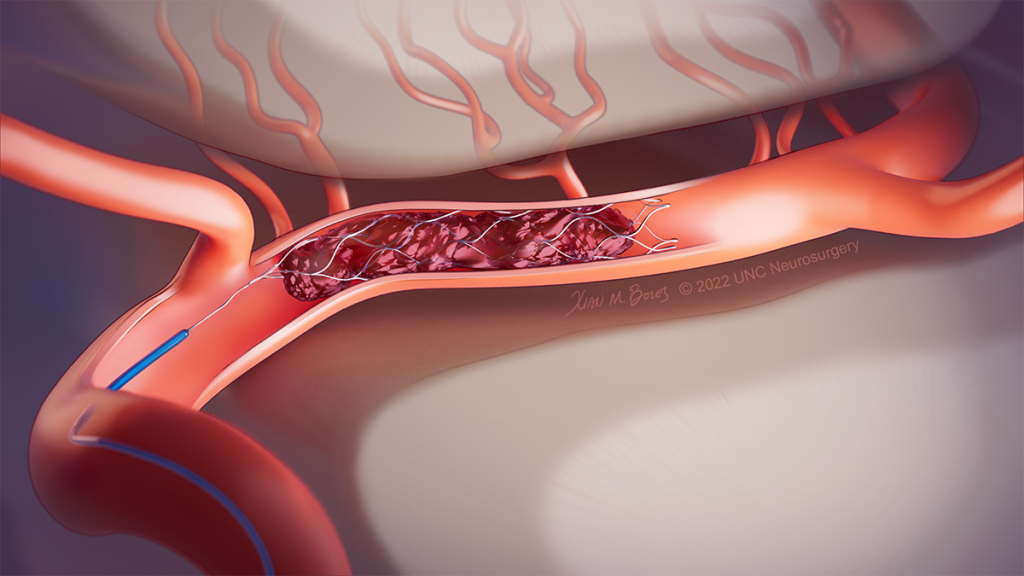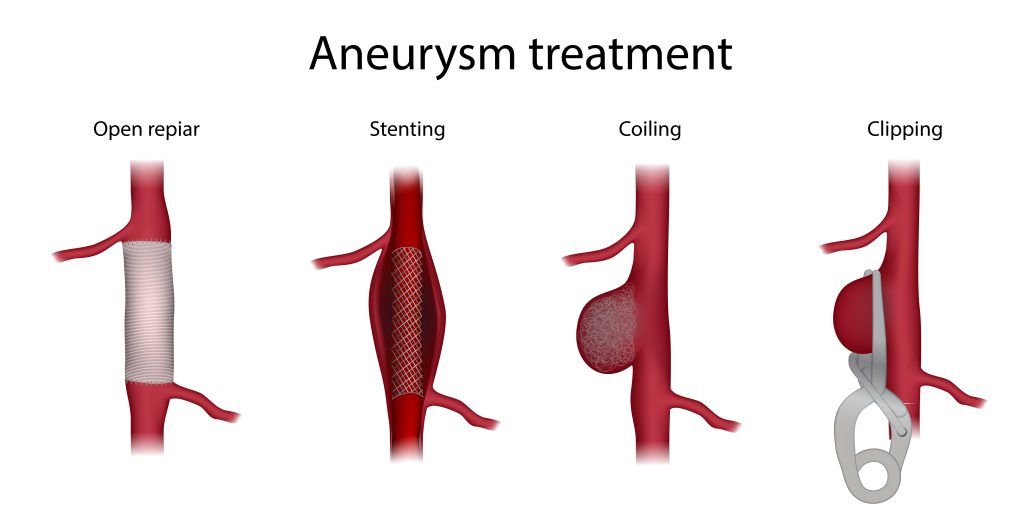Brain Aneurysm Treatment
A cerebral aneurysm, also known as a brain aneurysm or intracranial aneurysm, is a weakened area in the wall of a blood vessel in the brain that bulges out like a balloon. If the aneurysm grows too large and the vessel wall becomes too thin, it could burst and cause bleeding in the area surrounding the brain, which could lead to a very dangerous situation.

What occurs when an aneurysm in the brain bursts?
If it bursts, your blood will flow (hemorrhage) into the brain tissue nearby. This can create too much pressure on your brain and cause it to expand. Typically, this produces a very intense headache known as a thunderclap headache, as well as other signs.
The bursting of an aneurysm in the brain may result in severe medical complications involving:
- Subarachnoid hemorrhage (SAH) is characterized by bleeding that occurs in the space between the brain and the layer of tissue covering it, also called the arachnoid layer. A majority of these cases, around 90%, are caused by aneurysms in the brain that have ruptured.
- A hemorrhagic stroke refers to the occurrence of bleeding that takes place in the area between the skull and the brain.
The consequences of this situation may lead to enduring injury of the brain or other issues.
- Vasospasm occurs when blood vessels become constricted, leading to reduced oxygen supply to the brain.
- When there is an accumulation of cerebrospinal fluid or blood around the brain, it causes pressure on the brain which leads to Hydrocephalus.
- A seizure is an instance of uncontrolled electrical activity in the brain which is temporary. If caused by a ruptured aneurysm, it may exacerbate damage to the brain.
- Coma is a condition where the affected person remains unconscious for a significant period of time, which could range from several days to several weeks.
- Around 50% of individuals with ruptured brain aneurysms pass away.
What Causes Brain Aneurysms to Rupture?
Immediate medical attention is necessary in case of a hemorrhagic stroke resulting from the rupture or leakage of a brain aneurysm, which although infrequent, can pose a risk to life.
It is common for doctors to not have knowledge about the cause of your ruptured brain aneurysm. However, there are a few factors known to increase the likelihood of bleeding as per the experts.
The primary cause of a ruptured brain aneurysm is usually hypertension or high blood pressure.
Excessively exerting your body through lifting or straining can lead to the rupture of your brain aneurysm due to increased pressure.
Intense feelings can cause an increase in blood pressure and potentially result in the rupture of an aneurysm.
Medications, such as warfarin (Coumadin, Jantoven) that thin the blood and other prescription drugs like ephedrine and amphetamines used for weight loss, can result in blood vessel enlargements called aneurysms, leading to bleeding.

Symptoms of a ruptured brain aneurysm
Symptoms of a ruptured aneurysm include:
- A thunderclap headache is characterized by a sudden and intense onset, often referred to as the most excruciating headache a person has ever experienced.
- Nausea and vomiting.
- Stiff neck.
- Blurred or double vision.
- Sensitivity to light (photophobia).
- Seizures.
- Drooping eyelid and a dilated pupil.
- Pain above and behind your eye.
- Confusion.
- Weakness and/or numbness.
- Loss of consciousness.
Surgery and procedures
Preventative treatment options often involve the utilization of two primary techniques: neurosurgical clipping and endovascular coiling.
Both methods aim to obstruct blood flow into the aneurysm to prevent its rupturing.
Neurosurgical clipping
During the neurosurgical clipping procedure, general anesthesia is administered, causing you to be unconscious for the entire surgery.
A surgical incision is created on your scalp or potentially right above your eyebrow, and a tiny section of your skull is taken out to allow the surgeon to get to your brain.
Once the aneurysm’s location has been determined, the neurosurgeon will use a small metal clip to permanently seal it. Once the surgical bone flap has been put back in place, the scalp will be sutured closed.
Gradually, the inner walls of the blood vessels will mend at the position where the clamp is positioned, creating a permanent seal of the aneurysm and eliminating any possibility of its enlargement or burst in the future.
It is uncommon to cut off the artery responsible for forming the aneurysm instead of cutting the aneurysm itself. This course of action is typically reserved only for situations when the aneurysm is extremely large or intricate.
If required, this is frequently accompanied by a technique known as bypass. This entails redirecting the circulation of blood around the restricted region by utilizing a blood vessel extracted from a different part of the body, typically the leg.

Endovascular coiling for brain aneurysm
To perform this process, a catheter (a pliable tube) is inserted into a blood vessel, commonly in your groin or wrist, by either a neurosurgeon or an interventional neuroradiologist and navigated to the brain. Using the catheter, a minuscule coil made of pliable wire is placed into the aneurysm by the provider.
When the coil is introduced into the aneurysm by the provider, it brings about an alteration in the way blood flows within the aneurysm that leads to the formation of a clot. This clot blocks the passage of blood into the aneurysm, much like a clip, thereby sealing it.
Coiling versus clipping
The choice between using clipping or coiling for an aneurysm often relies on the aneurysm’s size, location, and shape.
Have a conversation with your healthcare providers regarding the treatment choices available to you. If there are multiple procedures that can be done, it is advisable to have a comprehensive discussion about the advantages and disadvantages of each option.
Research has demonstrated that coiling is typically associated with less immediate danger, such as seizures, than clipping.
Both methods carry a low risk of long-term bleeding.
Flow diverter surgery
This choice is intended for bigger brain aneurysms that cannot be treated through clipping or coiling. During this process, an artificial wall in the form of a metallic mesh stent is placed inside the artery to re-route blood flow around the aneurysm.
At what point should I make an appointment with my medical professional to discuss a brain aneurysm?
In case you have an unbroken brain aneurysm, it is important to visit your healthcare provider on a regular basis to keep an eye on the aneurysm’s size and to handle any risk factors that could contribute to it, such as high blood pressure.
If you have suffered from a ruptured brain aneurysm, you will have to visit your medical team frequently to observe and manage any potential issues while ensuring that you do not develop another aneurysm.
A note from rehabturk
An unruptured brain aneurysm may go unnoticed and not cause any harm throughout your life. However, there is always a possibility of it bleeding, posing a risk.
In the event of such an occurrence, you must seek urgent medical assistance. Delaying will result in a more severe outcome. With each passing moment after the rupture of your aneurysm, your chances of either death or disability increase significantly.
Approximately 75% of individuals who experience a ruptured brain aneurysm will survive beyond a 24-hour period. However, 25% of these individuals may suffer from life-threatening complications within the following 6 months.
In case your physician fails to promptly address your aneurysm, there is a possibility of experiencing bleeding from that same region. Therefore, it is crucial to seek immediate assistance if you observe any indications of a cerebral aneurysm.
Treatment in Türkiye:
The medical staff of surgical teams, doctors and consultants in Rehab Türk can provide the best treatment options and free consultations – by striving to keep abreast of the latest medical technologies and methods.

